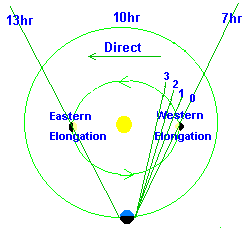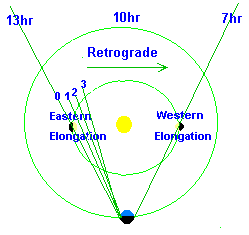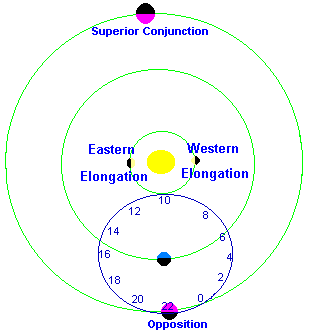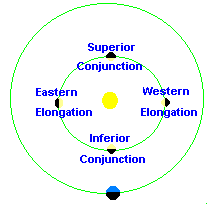The Motion of the Planets
by Dr Jamie Love © 1997 - 2011
© 1997 - 2011
 © 1997 - 2011
© 1997 - 2011
You know, all we've talked about is where the planets are, not how they move!
You're right. So let's move on. 
Now that you understand these fundamentals of planet positions we can start to make sense of their motion once you understand that
|
Imagine we are observing Venus. To make matters simple (to begin
with), let's imagine that the Earth is stationary so we will only
consider the motion of Venus. Let's start at Venus' greatest western
elongation - which (you will recall) is not drawn accurately (but close enough) in my diagrams.
Venus will appear as a morning object 47o to the
right of the Sun. (Right?) By the next morning Venus would
have moved (counterclockwise) in its orbit and we would discover
that Venus appears a little closer to the Sun. It has moved
eastward slightly and increased its RA slightly too. Indeed, each
morning Venus would get a little closer to the Sun - moving
further east and increasing its RA.
That motion appears to us as motion from west to east, or to look
at that a different way, Venus' right ascension is increasing.
| 
|
Motion from west to east (eastward) is motion of increasing right ascension and astronomers call that direct motion because it is the motion of most of the planets most of the time. Each night the planets move a wee bit eastward increasing their right ascension. (Of course, the RAs form a 24 hour clock-like circle so eventually the RAs get "reset" to 0hr.)
Eventually Venus will catch up with the Sun and be lost
in the Sun's glow. Venus will continue in its orbit as
it passes behind the Sun (at superior conjunction). Later, Venus will peek out from
the other side of the Sun but now it is on the opposite
side so it will be seen after sunset - Venus will now be an evening
object. Each passing evening we would see Venus moving further
from the Sun, increasing its RA as it continues to move
eastward (from west to east). This is still direct motion (eastward,
increasing RA) and it carries Venus further from the Sun so
each evening Venus will set later and later after sunset. When
Venus reaches its maximum eastern elongation it has reached the maximum
(apparent) distance from the Sun and something important
happens. Venus appears to change direction! 
|
After eastern elongation Venus can no longer continue to move
away from the Sun. Venus must complete its orbit and to
do that it appears to change direction. Now Venus moves towards
the Sun!
Each night, from our perspective, Venus now moves westward, from east to west, decreasing it RA in a motion that astronomers call retrograde motion. This retrograde motion will continue as Venus appears to move close to the Sun and each night its appearance after sunset will be briefer. Eventually Venus will be lost in the evening glow. Venus continues in this retrograde motion as its RA continues to decrease. Eventually Venus will have the same RA as the Sun and it will be in inferior conjunction. Venus' RA will continue to decrease as Venus continues to retrograde. We will not see Venus again until it appears as a morning object just before sunrise. Each morning it will be found a little further west of the Sun making Venus more visible before sunrise. | 
|
Of course, this retrograde motion ends when Venus reaches its greatest western elongation at 47o or about three RAs before the Sun.
Phew! Does Mercury do the same thing?
Yes. The only difference is that Mercury's greatest elongation is only 28o and it moves more quickly around the Sun so Mercury will change its direction several times a year. (Earth year, that is.)
Hey, when the planet moves in front of the Sun, at inferior conjunction, do we get an eclipse?
Yes! Well, no. Ah, well,  we don't have a real "eclipse" and it doesn't always happen anyway.
we don't have a real "eclipse" and it doesn't always happen anyway.
Could you explain that?!
Certainly. 
Most of the time the Sun and inferior planet have different
declinations during inferior conjunction.
You will recall that
the declination has to do with the "up and down" coordinate in the sky ("sky latitude") as opposed to RA which is the "left and right" coordinate ("sky longitude"). For one object to eclipse another they must both have the same RAs AND declinations. This adds an extra dimension to our view and we will return to this topic in June when I tell you the details of orbits and in July when I teach you about eclipses. For now, please accept that most of the time, when a planet crosses from one side of the Sun to the other, the planet travels a little bit above or below the image of the Sun.
However, on some occasions the inferior planet will share the same declination as the Sun (roughly) as it goes through inferior conjunction so it will actually pass across the Sun! This special kind of inferior conjunction is called a transit of the Sun.
Mercury is a little bigger than the Moon and Venus is about the size of the Earth but they are much (MUCH!) farther away from us so neither of them can actually eclipse the Sun. Eclipse means "to obscure" and transits don't really obscure the Sun. Instead, during a transit, the inferior planet will appear as a tiny disk that will seem to float across the face of the Sun! The amount of light it blocks out is so small that no one would notice it. Except astronomers. They will aim special telescopes at the Sun and planet while they watch this marvelous event. They will image the transit at a variety of wavelengths. Transits allow astronomers to study details of Mercury's orbit, surface and (very thin) atmosphere as it passes across the bright image of the Sun. When Venus transits the Sun astronomers do the same thing and learn about Venus' substantial atmosphere. Transits are very important events because there are only about a dozen transits of Mercury and two transits of Venus each century!
|
All transits of Mercury occur within a few days of 8 May and 10 November. That's because Mercury's orbit is inclined seven degrees to the Earth's orbit so it intersects the ecliptic at two points, called "nodes", which cross the Sun each year on those two dates. If Mercury passes through inferior conjunction at the same time it goes through a node, a transit will occur. Venus has a larger orbit so its transits are less frequent and they always occur in early December or early June when Venus's orbital nodes pass across the Sun.
If all this talk of ecliptic and nodes is confusing you, don't worry. We will come back to these ideas later in our course after I have taught you more details about orbits. |
I will tell you (in the Night Sky this Month) when transits are due BUT NEVER STARE AT THE SUN even during a transit! Of course, professional astronomers know how to view the Sun safely and have special instruments to help them. You cannot watch transits without special equipment.
Transits are the only time when you really have to think about a planet's declination - unless you are trying to be very precise in your understanding of the planet's motion and, like I said, we will come back to that in a few months. Let's get back to RAs because that is the coordinate that really dominates our understanding of planet motions. It is the changing RA of a planet that makes it so hard to track from one night to the next because the RAs change during direct or retrograde motions. (Declinations change very slightly.)
OK. Hey, do superior planets bounce around the Sun, retrograding and such?
|
Not really, but they do show a small amount of retrograde motion during opposition. We'll come to that small exception in a moment but first let's talk about the overall motion of the superior planets.
The superior planets go completely across our night sky so they don't need to bounce back and forth to complete an orbit. They usually just move along in a smooth direct motion. Each night the superior planets move very slightly eastward (west to east) against the starfield and increase their RA as they orbit the Sun. (Remember, stars don't change their RAs or declination so the "starfield" is a constant map.) Recall that the RAs form a circle around the Earth. This image reminds you of that fact but does so in a rather unusual way. Take a good look at this diagram and try to understand that an inferior planet must retrograde in order to complete its orbit. Inferior planets undergo direct motion as they move from western to eastern elongation and they undergo retrograde motion as they move from eastern to western elongation. Inferior planets spend half their time in direct motion and half their time in retrograde motion. They must do that in order to complete their orbits. But think about the motion of that superior planet. | 
|
I understand. There's no need for superior planets to retrograde in order to complete their orbits.
Right.
So, superior planets are ALWAYS in direct motion.
Ah, not quite true.
Remember, we have made a simplification in order to help us come
to grips with this difficult topic. We have been assuming that
the Earth is stationary. Of course, it is not. The Earth is also
moving counterclockwise around the Sun and that adds a
wee complication.
As the Earth "catches up" to a superior planet and "passes" it, there is a period when the planet will move against the starfield in an east to west direction - decreasing its right ascension! This is retrograde motion but for a different reason!
|
In this diagram I had to be very excessive with the arc of Earth's
orbit in order to make the image of reasonable size.
At first we see Mars, the red planet, moving eastward in direct motion as
it does most of the time. That's the motion we expect to see as
illustrated from point 1 to 2. Mars' RA is increasing.
Note: in this image it appears that retrograde motion is right to left but that is only the way it is drawn. Check with the RA circle in the previous diagram to really get your bearings and to correctly understand the changing RAs. (And remember, as the RA move from 24 to 0 it is still direct motion - the clock is just resetting because we cannot have 25 hours of RA!)
Mars is the only planet with obvious retrograde motion.
| 
|
Here's a little recap about motion.
Direct motion is "normal" motion. It is eastward (west
to east) and increases right ascension.
Retrograde motion is "backwards" motion. It is westward
(east to west) and decreases right ascension.
|
The inferior planets spend half their time in retrograde motion as they
move from their greatest eastern elongation to their greatest
western elongation. (Notice that retrograde is east to west and
inferior planets use retrograde to go from eastern to western
elongation. Easy to remember.) The inferior planets use direct
motion, from west to east, as they move from their western elongation
to their eastern elongation. (Direct motion is west to east and
the inferior planets use it to go from western to eastern
elongations. Easy!) These motions have nothing to do with the
motion of the Earth. Indeed, we ignored the Earth's motion in order
to make it easier to understand. Fact is, even the Earth's own
motion has no real affect on the retrograde or direct motion of
the inferior planets. (But it does affect the exact times and
dates when it occurs. More or that later.)
The superior planets are always moving west to east (eastward) in direct motion, but as they approach opposition they do a little "retrograde dance" that is actually caused by the motion of the Earth. The retrograde of the superior planets is small and brief. [This diagram would make a nice entry in your notebook!] | 
|
So an inferior planet always starts retrograde motion once it reaches its greatest eastern elongation. Right?
Ah, well, from this diagram you might think so but remember that I made things easy by ignoring the motion of the Earth when I introduced you to these ideas. Recall that, by definition, retrograde motion is westward, from east to west, causing a decreasing in RA. An inferior planet can reach its greatest eastern elongation but still maintain directed motion (increasing its RA and continuing to move eastward) because of the motion of the Earth!
This is complicated but I'm sure you can understand it with a little explanation and a lot of thought. Here goes.
Elongation is measured as the (angular) distance between the planet's position and the Sun's position but the Sun's position is really caused by the Earth's position. And the Sun's apparent motion is really caused by the Earth's motion. (Right?) Let's say that Venus reaches its greatest eastern elongation - its farthest apparent eastern (angular) distance from the Sun. After greatest eastern elongation the distance between the Sun and Venus MUST decrease but that does not necessarily mean VENUS must change its direction to move closer to the Sun. Venus can stay still while the Sun (moving it direct motion) catches up to Venus! Of course, what is really happening is that the Earth is swinging through its orbit and that makes the Sun move through the sky but it looks as if the Sun is chasing Venus. Venus and the Sun can continue in direct motion and, as long as the Sun moves faster (through more RA) than Venus, the (angular) distance between them will decrease - as it must because Venus has passed its greatest eastern elongation. (Right? Still with me?  Think about it a little bit. Draw it.)
Think about it a little bit. Draw it.)
It is common for an inferior planet to continue its direct motion after reaching greatest eastern elongation because the Sun is ALWAYS in direct motion. All the inferior planet has to do is appear to move more slowly than the Sun in its direct motion. Of course, eventually, that planet will retrograde but exactly when that starts depends upon the Earth's motion.
The opposite effect also occurs, and complicates motion, as an inferior planet reaches greatest western elongation. I won't go into it, but I hope you will agree (and, perhaps draw it out to convince yourself) that a retrograde motion does not necessarily switch to direct motion on the day that the inferior planet reaches greatest western elongation.
Yes, this is complicated!
OK. So, do Mars opposition and retrograde motions happen once a year as the Earth returns to its position?
Ah, no. If Mars were in opposition tonight, one year from now the Earth would have returned here but Mars would have moved on. Now Earth has to play catch up and, of course, Mars is moving along too. These two motions cause Mars oppositions to occur every 780 days. Mars underwent retrograde motion in the year 1999 and again in 2001 but Mars did not retrograde in 2000.
You will recall from last month's lesson that a synodic period is the time between successive returns to the same position relative to the Sun as seen from Earth. That's what really matters in observational astronomy - synodic period.
You learned about synodic and sidereal periods last month when I taught you about the Moon's motion around the Earth and the motion of the Earth-Moon system around the Sun.
Let's recall some ideas from last month's lesson and apply them
to planets.
All the planets orbit the Sun at different speeds so they
all have different sidereal periods (the time to complete
one orbit of the Sun and return to the same position with
respect to the stars). By the time the Earth has returned
to its starting point (after one Earth year - its sidereal period)
the other planets have moved on and changed their position with
respect to the stars (sidereal position) and Sun.
Consider Mercury. It moves so fast around the Sun (sidereal
period of 88 days) that is actual "laps" the Earth (passes
it) several times a year. Mercury has a synodic period of 116
days. That means Mercury reaches greatest eastern elongation, or
any other part of its synodic cycle, every 116 days. It doesn't
reach greatest eastern elongation in 88 days (its sidereal period)
because after 88 days the Earth has moved on a little further
so Mercury has to catch up to the Earth at its new position in
order to "present" itself to the Earth.
For example, Mercury was at its greatest eastern elongation on December 3rd 1999 and again at its greatest eastern elongation on June 9th 2000 and October 6th 2000.
[Note : If you count that out you'll discover that it doesn't quite fit 116 days. That's because the synodic period for planets is an average and we have not taken into account a complication in orbit shapes that is particularly pronounced for Mercury. We'll come back to that some other day. However, you get the general picture.]
Venus also moves faster than the Earth. Its sidereal period is 225 days, but by the time it returns to its sidereal position the Earth has moved over to the other side of its orbit. It takes Venus a total of 584 days to complete its synodic period. Therefore, Venus reaches inferior conjunction, or superior conjunction, or each maximal elongation every 584 days.
We've already discussed Mars. It has a synodic period of 780 days. (But a sidereal period of 687 days.)
As we move further away from Earth the planets become more and
more distant and their motion through the night sky is slower.
The RA of the "giant planets" (Jupiter, Saturn, Uranus
and Neptune) changes very, very slowly. Therefore the Earth's
sidereal period becomes a dominant factor. The further away the
planet, the closer its synodic period approaches the Earth's sidereal
period.
Jupiter has a synodic period of 399 days.
Saturn has a synodic period of 378 days.
Uranus has a synodic period of 370 days.
Neptune has a synodic period of 367.5 days.
And Pluto has a synodic period of 366.7 days.
If there are planets beyond the orbit of Pluto, their synodic periods would be less than 366.7 days. Indeed, if they were very far away (like a comet in the Oort cloud which you will learn about in August) their synodic period would be very much the same as the Earth's sidereal period of 365.24 days. When you think about it, the far distant objects, like stars, have periods of exactly that of the Earth's sidereal period!
There's a lot to learn about planet motion!
Yes, there is!
You may be disappointed to know that there is even more to learn!
Notice that throughout this lesson I have limited myself to discussing planet motion on a flat "plane".
That's why we have been talking about right ascension and east-west
orientations. The bad news is that the planets move in three dimensions
so to fully understand them you have to take that into account
and include declinations along with right ascensions. Also, we
have been imagining the orbits of planets to be perfect circles
when in fact planets follow orbits that are slightly squished
circles, called ellipses.
The good news is that these extra factors are only needed if you
want a more detailed understanding of planetary motion to explain
things like eclipses, occulations and the slight variations in periods.
We'll, come back to those complications in a couple months.
But first, you should master this lesson. Be sure you understand this stuff. No one understands this complex material the first time it's read.
OK, I'll go through it until I understand it.
Good. Any last questions.
Yeah. Earlier you mentioned the Moon and that made me wonder. Do planets go through phases?
Good question!
Due to their position with respect to the Earth, inferior planets
go through phases similar to the Moon's.
|
You'll recall that the
phases of the Moon have to do with the way we see the sunlit side
of the Moon from our position here on Earth. The same is true
for Mercury and Venus although it is impossible to see the complete
cycle.
A planet at superior conjunction will be "full" because
it presents its fully lit face to Earth, but it also happens to
be on the opposite side of the Sun and you know that makes
observations impossible. At inferior conjunction a planet is "new"
but it is also lost in the Sun's glare. (So who cares! At other times an inferior planet can have any of the other phases however "crescent" and "old" are difficult to see, "quarters" are possible to see but "waning" or "gibbous" make the best viewing. | 
|
You need a telescope to actually see the phases and it is particularly
difficult to see the phases of Mercury because it's so close to
the Sun. Venus, however, is quite a "phaser"
(that's not a real word) and this affects Venus' magnitude. From
our Earthbound perspective Venus can have a magnitude as high
as -4.4 when showing its best phase. Due to the geometry of the
orbits, Venus' maximum magnitude occurs about 36 days before western
elongation (when it will be a morning object) and about 36 days
after eastern elongation (when it will be an evening object).
[I'll spare you the details of that but rest assured you could
understand it with some more maps and geometry.]
I understand. Venus can go through phases but not Mars. Mars is always "full". Right?
Ah, well, ah ....
Mars is pretty close to us and when it is near quadrature it shows
a phase similar to that of our Moon a day or two before it is
full. You need a telescope to see it and this only barely affects
Mars' magnitude but it does appear to be about 85% full when near
quadrature.
All the other superior planets show a "full" face to us. They are too distant for the orbital geometry to have much of an effect.
Perhaps you have other questions about planet motion, but I think
we've covered a lot here and I don't want to wear you out!
Instead I encourage you to give this lesson a lot of time and
thought so it really sinks in. These last two lessons are the most difficult
ones in the bunch! Some students will go through this and conclude
"Planetary motion is complicated. Too complicated to understand."
Don't give up. All you have to do is give it the proper amount
of study and you will master it.
Planetary observations are an exciting part of astronomy, especially
with a telescope, but even with the naked eye you should be able
to see these events and understand them.
Now that you have made it through a quarter of the course you should begin to feel you have a better understanding of astronomy. The explanations in the Night Sky this Month should start to make sense. Indeed, now you should be able to read those events with an understanding of what they mean and why the observations happen as they do.
See you next month.
Wishing you "Clear Skies".
Jamie  (Dr Love)
(Dr Love)








